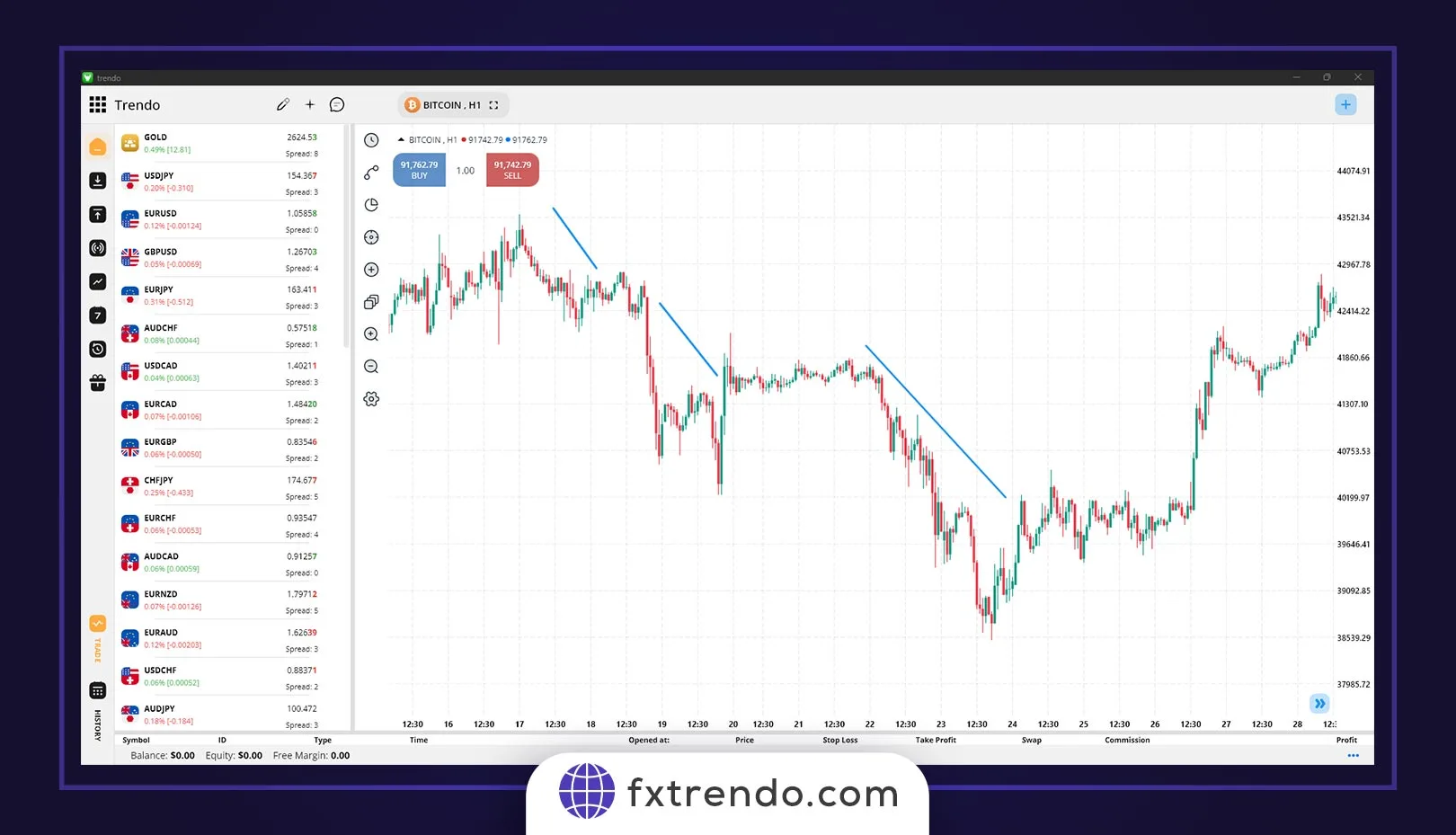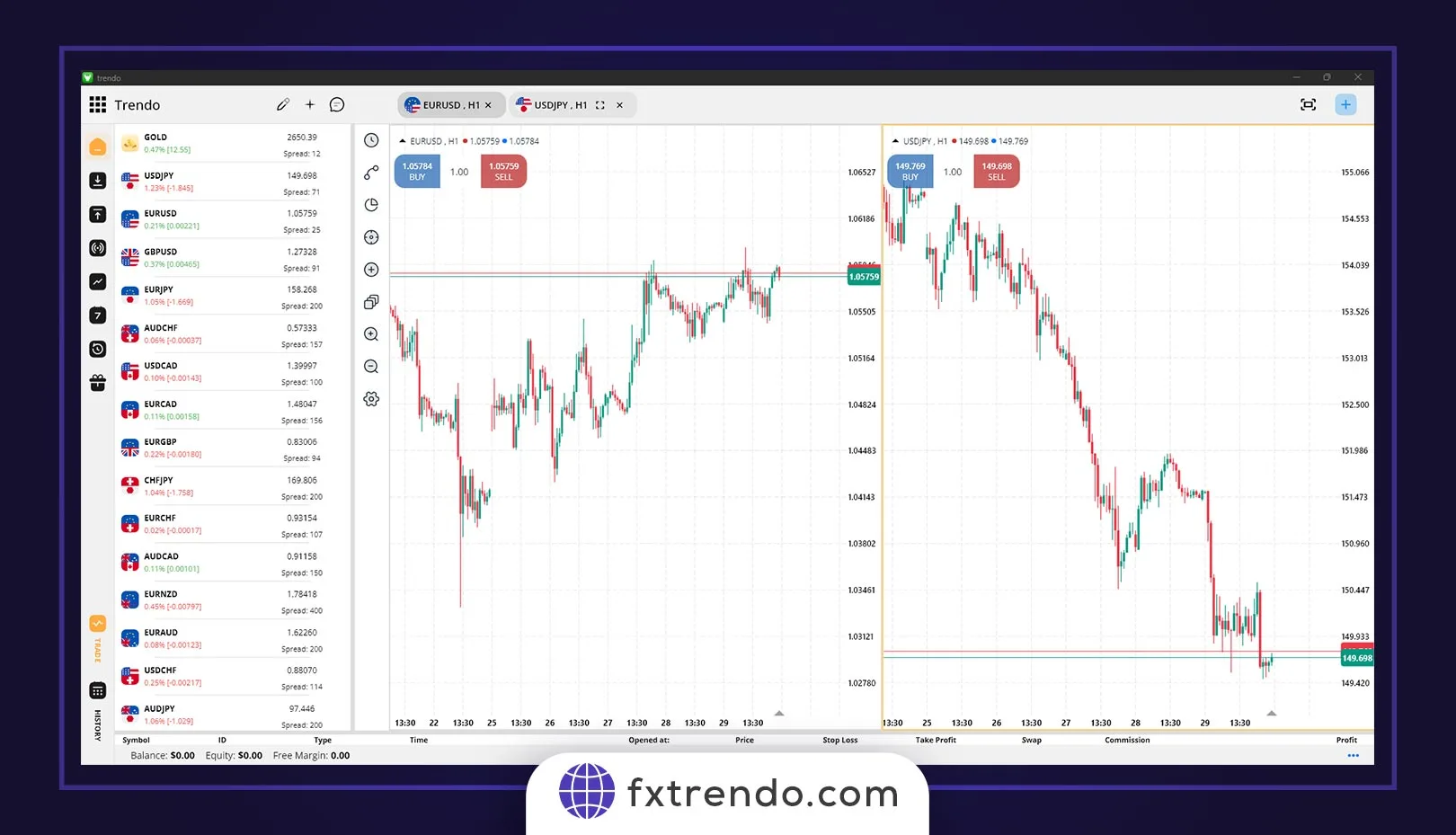This article explores the currency pairs and trading symbols offered by Trendo, helping you optimize your strategy. Whether trading currencies, digital assets, or commodities, you’ll find options to match your goals.
Let’s dive into Trendo’s offerings.
What is a Forex Currency Pair?
The Forex market, being the largest financial market in the world, serves as the primary platform for trading major international currencies such as the US Dollar, Euro, British Pound, and others. In this market, all trading symbols are presented in pairs, which is a fundamental concept for Forex trading. Essentially, the value of any currency or asset in the Forex market is always quoted relative to another currency or asset.
For example, in the currency pair USDCAD, you have two components: USD (United States Dollar) and CAD (Canadian Dollar). The first currency in the pair, USD, is called the base currency, while the second currency, CAD, is referred to as the quote currency or counter currency. If the price of the USDCAD pair is quoted at 1.40, this means that 1 US Dollar is equal to 1.40 Canadian Dollars. The price tells you how much of the quote currency (CAD) is needed to purchase one unit of the base currency (USD).
Read more: What is a Currency Pair? (What is traded in Forex?)
When trading Forex, the way you enter a position depends on whether you are buying or selling the currency pair:
Buying a currency pair (going long):
means that you are buying the base currency and selling the quote currency at the same time. For example, if you buy the USDCAD pair, you are purchasing US Dollars and simultaneously selling Canadian Dollars.
Selling a currency pair (going short)
means that you are buying the quote currency and selling the base currency. If you sell USDCAD, you are selling US Dollars and buying Canadian Dollars.
Types of Forex Currency Pairs
In the Forex market, currency pairs are typically divided into two main categories:
- Major Currency Pairs
- Minor Currency Pairs
Let’s explore each of these categories in detail.
Major Currency Pairs
The most important currencies in the world are part of the Major Currency Pairs. These include:
- US Dollar (USD)
- Japanese Yen (JPY)
- Euro (EUR)
- British Pound (GBP)
- Canadian Dollar (CAD)
- Australian Dollar (AUD)
- Swiss Franc (CHF)
- New Zealand Dollar (NZD)
Since the US Dollar is the world’s primary reserve currency and dominates global trade, most Forex transactions involve the USD. Therefore, any pair that includes the US Dollar and another major currency is considered a Major Currency Pair. Some of the most traded pairs in this category include:
- EURUSD (Euro / US Dollar)
- USDJPY (US Dollar / Japanese Yen)
- GBPUSD (British Pound / US Dollar)
- USDCAD (US Dollar / Canadian Dollar)
- AUDUSD (Australian Dollar / US Dollar)
- NZDUSD (New Zealand Dollar / US Dollar)
- USDCHF (US Dollar / Swiss Franc)
These pairs represent the highest trading volumes in the Forex market, making them the most liquid and widely traded. The EURUSD pair, in particular, stands out due to its liquidity, offering low spreads and low commissions. Traders often prefer EURUSD because of its low trading costs and abundant opportunities for profit.
For example, EURUSD accounts for about 25% of total Forex market transactions. The strong economic ties between the United States and the European Union make this pair the most popular. Since EURUSD has high liquidity, traders enjoy tight spreads, often close to zero.
EURUSD Currency Pair
The Euro to US Dollar (EURUSD) currency pair is the most important, famous and popular currency pair in the Forex market, and many traders and investors trade this symbol. This currency pair accounts for 25% of all Forex market transactions.
The popularity and high volume of transactions in this currency pair is due to the fact that the United States and the European Union have the largest economies and financial turnover in the world.
In fact, the best Forex symbol for trading is the Eurodollar. The high volume of transactions in this currency pair has created many trading opportunities for traders, and for this reason, the trading spread in this symbol has decreased significantly.
It is worth noting that the spread of the Eurodollar (EURUSD) currency pair in the Trendo broker is zero and you can trade this symbol in the Trendo broker without a spread!
To register with Trendo Broker, simply download Trendo’s professional and dedicated trading platform for your desired operating system, complete the registration process in just 10 minutes, and connect to the global international markets.

To trade EURUSD currency pair, traders should pay attention to the economic situation of the European Union and the United States in addition to technical factors.
They should also follow and examine important economic news from the European Union and the United States, such as interest rates, inflation, and other factors affecting currency fluctuations, through the economic calendar.
The better the economic situation in Europe, the higher the price of this currency pair will be, and the better the economic situation in the United States, the lower the price of this currency pair will be, because the dollar is on the other side
Read more:Forex Calculator
GBPUSD (British Pound / US Dollar)
The GBPUSD pair represents about 11% of total Forex market transactions. Its volatility is heavily influenced by economic conditions in both the UK and the US. The Pound tends to fluctuate more than other currencies due to the UK’s dynamic political and economic situation. Similarly, the US Dollar’s strong market presence adds further volatility.
GBPUSD is considered one of the most volatile pairs, offering traders numerous opportunities. Traders looking to take advantage of price swings find this pair particularly attractive. The GBPUSD pair in TrendO can be traded with the lowest spreads, and at times, even with zero spread.
USDJPY (US Dollar / Japanese Yen)
The USDJPY pair is closely watched by traders due to Japan’s stable economy and low-interest rates. The Japanese Yen is considered a safe-haven asset, meaning it is in demand during times of economic uncertainty or risk. On the other hand, the US Dollar is influenced by broader market factors such as global trade and US economic data.
Traders tend to focus on USDJPY when markets are volatile, as it can offer strong trends. Japan’s economy is also highly export-driven, which impacts the Yen’s strength against the US Dollar.
Read more: What is a pip in Forex?
Minor Currency Pairs
Minor Currency Pairs, also known as Cross Currency Pairs, do not involve the US Dollar but are made up of two major currencies. These pairs offer traders additional opportunities to diversify their portfolios. Some examples of Minor Currency Pairs include:
- EURJPY (Euro / Japanese Yen)
- EURGBP (Euro / British Pound)
- GBPJPY (British Pound / Japanese Yen)
- GBPCAD (British Pound / Canadian Dollar)
- EURAUD (Euro / Australian Dollar)
While these pairs do not include the US Dollar, they still attract considerable trading volume. Since they are typically more volatile than Major Pairs, they present additional risk and reward for traders. Traders looking for alternative opportunities can benefit from the fluctuations in these currency pairs.
With Trendo, you can access Minor Currency Pairs with low spreads and commission fees, as well as a robust trading platform designed for seamless execution.
Factors Influencing Forex Currency Pairs
Currency pairs in the Forex market are influenced by several key factors. Understanding these factors can help traders make informed decisions and predict market movements. Here are the main factors that affect currency pairs:
1. Interest Rates
Interest rates set by central banks have a direct impact on currency values. Higher interest rates attract more foreign investment, increasing demand for the currency and strengthening it. Lower interest rates tend to weaken the currency, as investors seek higher returns elsewhere.
For example, if the Federal Reserve raises interest rates, the USD typically strengthens as investors move money into the US to take advantage of higher returns.
When the European Central Bank cuts interest rates, the EUR often weakens as investors move to other currencies with higher yields.
2. Economic Indicators
Economic indicators like GDP, inflation, and employment data provide a snapshot of a country’s economic health. A strong economy usually leads to a stronger currency, while a weak economy can cause a currency to decline.
GDP Growth:
Strong GDP growth often leads to a stronger currency, as it signals a growing economy and attracts foreign investment.
Inflation:
High inflation erodes purchasing power, weakening a currency, while low inflation supports currency strength.
Employment Data:
A low unemployment rate is generally a sign of economic stability, which can boost the value of a currency.
3. Geopolitical Events
Geopolitical events, such as elections, wars, or international agreements, can create uncertainty in the Forex market. Political instability often leads to a weaker currency, as investors seek safer assets.
Events like Brexit caused volatility in the GBP due to the uncertainty surrounding the UK’s departure from the European Union.
Positive geopolitical developments, such as trade agreements or peace treaties, can boost investor confidence and strengthen a currency.
4. Market Sentiment and Speculation
Market sentiment and speculation are key drivers in currency price movements. Traders often buy or sell currencies based on future expectations rather than current economic conditions. If investors believe a currency will rise in value, they may start buying it, driving up the price.
For instance, if traders expect an interest rate hike by the Federal Reserve, they may buy the USD in anticipation, which strengthens the currency even before the actual rate change.
5. Commodity Prices
Commodity prices are linked to currencies in countries that are major exporters of natural resources. The Australian Dollar (AUD), Canadian Dollar (CAD), and New Zealand Dollar (NZD) are particularly sensitive to commodity price changes.
A rise in crude oil prices, for example, can strengthen the CAD, as Canada is a major oil exporter.
Similarly, a rise in gold prices can lead to a stronger AUD, as Australia is one of the world’s largest gold producers.
6. Central Bank Interventions
Central banks can directly influence currency prices by intervening in the Forex market. These interventions are usually aimed at stabilizing the currency or achieving specific economic goals, such as controlling inflation or boosting exports.
For example, the Swiss National Bank has intervened in the past to prevent the CHF from appreciating too much, which could harm Switzerland’s exports.
Countries may also devalue their currency intentionally to make their exports cheaper, increasing demand for their goods.
7. Global Risk Appetite
Risk appetite refers to how willing investors are to take on risk. In times of uncertainty or crisis, investors tend to move their money into safe-haven currencies like the USD, CHF, or JPY, which are considered stable.
During periods of global financial instability, the USD and JPY often strengthen as investors seek safer investments.
In more stable times, investors may seek higher yields from riskier currencies like the AUD or NZD, leading to a decline in safe-haven currencies.
8. Trade Balances
A country’s trade balance also affects its currency. Countries that export more than they import (trade surplus) typically see their currency appreciate, as demand for their goods also increases demand for their currency.
If a country like China has a trade surplus with the US, the demand for the CNY rises, which strengthens its value.
On the other hand, countries with a trade deficit, where imports exceed exports, may see their currency weaken due to lower demand for their goods and currency.
By considering these factors, traders can better anticipate market changes and improve their chances of success in Forex trading.
Precious Metals in International Financial Markets
Precious metals, particularly gold, are highly popular in international financial markets. Traders around the world frequently engage in trading gold (XAUUSD), silver (XAGUSD), and other commodities like oil, especially through Forex brokers.
While Forex markets primarily involve currency pairs, brokers often provide access to commodities and precious metals as part of their offerings. This makes it possible for traders to diversify their portfolios by including metals like gold, silver, palladium, and platinum.
These assets are considered safe havens during periods of economic uncertainty and are actively traded in the global markets.
Gold (XAUUSD) in Forex
Gold is one of the most traded precious metals in the financial markets. It’s widely recognized as a safe-haven asset, which means it tends to hold or increase its value during times of economic or political instability.
For example, during global crises, wars, or economic recessions, gold prices typically rise as investors seek to protect their capital from market volatility. Gold’s appeal as a safe asset is largely driven by its historical stability and ability to maintain value when other investments are volatile.
The gold market (XAUUSD) is also highly liquid, meaning that traders can buy and sell it easily without large price fluctuations, making it an attractive asset for both short-term and long-term traders.
Since gold is traded in US dollars, the value of the USD plays a crucial role in determining the price of gold. When the US dollar strengthens, gold prices often fall, and when the dollar weakens, gold tends to rise.
For gold trading, choosing a broker is very important, you can check the important points in choosing a broker for gold trading in the Features of the Best Broker for Trading Gold article.
The Trendo broker undoubtedly offers one of the best trading conditions for the gold symbol and the main currency pairs of the Forex market. In the image below you can see the spreads of the most important Forex market symbols on the Trendo platform:

Other Precious Metals: Silver, Palladium, and Platinum
Silver (XAGUSD), like gold, is considered a precious metal with significant market interest. While silver is more volatile than gold, it shares similar characteristics as a safe-haven asset, responding to economic uncertainty in much the same way. Silver is often seen as a more affordable alternative to gold, attracting smaller investors who want exposure to precious metals without the higher price tag of gold.
Palladium and platinum are also important in the precious metals market, though they are less commonly traded than gold and silver. These metals are primarily used in industrial applications, such as the production of catalytic converters in automobiles. Their prices can be influenced by demand from the automotive industry, making them more susceptible to industrial trends and economic cycles.
Trading Precious Metals with Brokers
When trading precious metals, selecting the right broker is crucial. A good broker provides access to competitive spreads, high liquidity, and the ability to trade a variety of precious metals.
For instance, with Trendo Broker, traders can access a wide range of commodities and metals under favorable trading conditions. This includes global gold (XAUUSD), silver (XAGUSD), palladium (XPDUSD), and platinum (XPTUSD) pairs.
In addition to offering competitive spreads, Trendo provides trading platforms that make it easy to execute trades efficiently and at the best possible prices.
The choice of broker can have a significant impact on your trading experience, so it’s essential to look for one that offers reliable execution, low commissions, and responsive customer support when trading precious metals.
Key Indicators of Global Markets on Trendo Broker
Trendo Broker offers a range of major stock market indices, alongside Forex and precious metals, giving traders access to broader global markets. These indices are valuable tools for understanding overall market performance and trends. Here are the key indices available on Trendo Broker:
- DOW JONES
- S&P 500
- DAX 40
- NASDAQ
- APAN 225
- ASX 200
DOW JONES and NASDAQ
DOW JONES (DJI or US30)
The Dow Jones Industrial Average is one of the oldest and most recognized stock indices. It tracks the performance of 30 major US companies across a range of industries like technology, finance, and consumer goods. The DJI (or US30) is often used to gauge the overall health of the US economy. It tends to be less volatile than tech-heavy indices but can still react to major economic events, like changes in interest rates or geopolitical tensions.
Read more :What is the Dow Jones Index?
NASDAQ (NAZDAQ or US100)
The NASDAQ Composite index focuses on technology and innovation. It includes major tech companies like Apple, Microsoft, and Amazon, making it a benchmark for the tech sector. The NASDAQ-100 (or US100) tracks the top 100 non-financial companies listed on the NASDAQ exchange. It’s more volatile than the Dow, with movements often tied to developments in the tech industry, offering both high-risk and high-reward trading opportunities.
Other Key Global Indices on Trendo Broker
S&P 500:
Tracks 500 of the largest US companies, offering a broader view of the US economy compared to the Dow. It’s popular among long-term investors.
DAX 40:
Tracks the 40 largest companies on the Frankfurt Stock Exchange in Germany, providing insight into the German economy.
JAPAN 225:
Known as the Nikkei 225, this index covers 225 major companies in Japan, reflecting the performance of the Japanese economy.
ASX 200:
Tracks the 200 largest companies on the Australian Securities Exchange, providing a snapshot of the Australian stock market.
Cryptocurrencies on Trendo Broker
Trendo Broker provides access to some of the most popular cryptocurrencies, allowing traders to participate in the growing digital asset market. In addition to Forex, commodities, and stock indices, Trendo offers a variety of major cryptocurrencies.
Here are the key cryptocurrencies available for trading on Trendo Broker:
- Bitcoin (BTC)
- Ethereum (ETH)
- Ripple (XRP)
- Litecoin (LTC)
- Dogecoin (DOGE)
- Cardano (ADA)
Bitcoin (BTC) on Trendo Broker
Bitcoin (BTC) is the leading cryptocurrency and remains one of the most traded assets. Available on Trendo Broker as BITCOIN (BTC), it offers traders high liquidity and volatility. Bitcoin is considered a store of value and a speculative asset, influenced by factors such as market adoption, regulations, and global economic trends.
Trendo Broker offers Bitcoin with low spreads and commissions, making it an efficient option for traders seeking to capitalize on price fluctuations.
Other Cryptocurrencies on Trendo Broker
Trendo also offers several other well-known cryptocurrencies:
Ethereum (ETH):
The second-largest cryptocurrency by market cap, known for its blockchain that supports smart contracts and decentralized applications.
Ripple (XRP):
A digital payment protocol that facilitates fast and low-cost cross-border payments.
Litecoin (LTC):
A faster and more scalable version of Bitcoin, known for quicker transaction times and lower fees.






